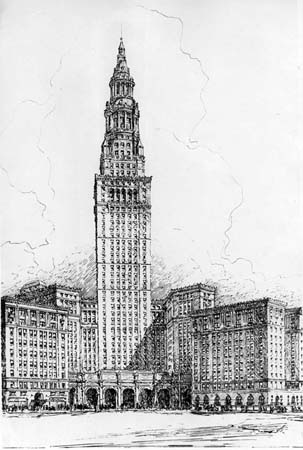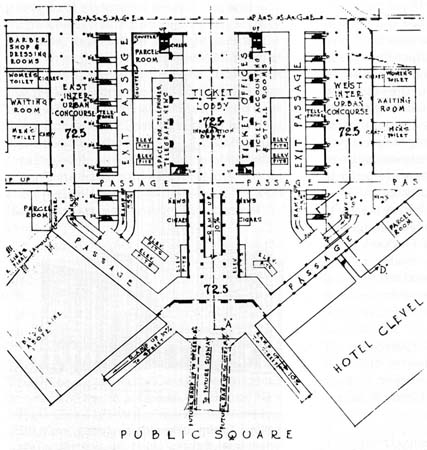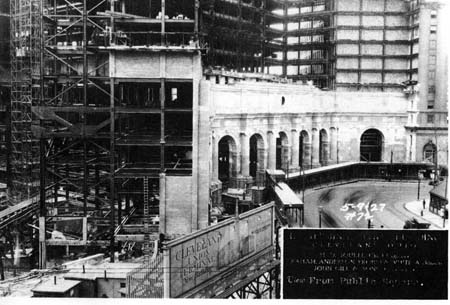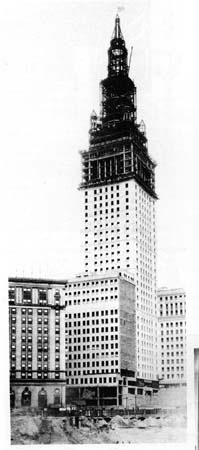
|
| Terminal Tower, architect's rendering, early 1925. Ornamental figures along portico were later eliminated because of expense. CSU Archives. |
Continued from: "A monumental secret"
The decision to make the tower 52 stories high had important visual
consequences as well. It would no longer just accent the entrance
to the station. By its sheer height and diagonal placement the
tower would dramatically pierce the quadrilateral symmetry of
the Square, and to the Square's heretofore chaotic impact it would
contribute a consistent order, a clear image on two sides which
people could recognize and remember.
Another important change was made from the design of 1918: the
tower was set back. The entrance, newly conceived as a portico,
now jutted forward, and had an identity of its own. This visual
separation not only expresses a difference in function -- entry
versus office space -- but creates a totally different visual
relationship between tower and entry. The entrance and the groundline
no longer serve as a base for the tower, as they did in the 1918
proposal, but the tower is now seen as rising from behind the
portico. The idea for a great vestibule, clearly separated from
the connecting office building towering above, was first employed
in Michigan Central Station, built in 1913 in Detroit. This advanced
in functional expressionism was further developed in Cleveland.
Because the shape of the Terminal Tower is visually incomplete
at this lower juncture, a sufficiently strong tendency towards
visual completion is generated: the impression is created that
the tower emerges from a subterranean base. This composition gives
visual expression to the station below, which was lacking in the
1918 proposal.
This separation of portico and tower resulted not only from visual
considerations, but from a legal one as well. Since the site was
Public Square, the City had no right to vacate the triangular
piece of land in the southwest corner. This property was owned
by the public, as distinguished from the city, and consequently
the City only had the right to occupy it for a public use. Therefore,
the tower had to be set back away from the Square. In order to
permit construction of the portico, City Council passed an ordinance
which gave license to construct an ornamental arcade passageway
that would be open at all times for pedestrian travel. 42
This ordinance also established the street grades for the corner.
Notice how today the grade declines toward the entrance from both
Ontario Street and Superior Avenue. This condition made it possible
the interior ramp slope of no more than 10 percent; otherwise,
because of the shallowness of the site, it would have had to be
much steeper. Even at 10 percent, it is too steep to be comfortable.

|
| Terminal Tower, architect's rendering, early 1925. Ornamental figures along portico were later eliminated because of expense. CSU Archives. |
Vistas of unimpaired vision create a crescendo effect, and the
long narrow proportions of the tower's mass play an important
part in making the eye rise from ground level to higher elevations.
43
This effect is reinforced as all the horizontal design elements
are seen first in their relation to the vertical order. The vertical
stresses isolations, ambition, and competition; the horizontal
suggests interaction. The mass of the tower contrasts with the
mass of the wings, as the viewer's gaze moves back and forth between
them. Looking at the total composition is a dynamic experience.
Since the interspaces between Higbee's, the tower, and the hotel
are nonexistent, these units coalesce into one. They do not display
mutual repulsion as the Old Stone Church does to its neighboring
buildings. Each needs the other for reciprocal completion.
The tower provides an anchor to the observer's glance, a relief
from the excessive horizontality of Public Square. It creates
spatial coordinates -- a framework for determining distances and
orientation Clad in masonry, it has no reflecting glass walls
which can create surrealistic images. Its form is not ambiguous;
it sends out a firm and clear message of pride and aspiration.
The tower does not look forlorn in its setting, as does the Erieview
Tower, for example, for it has a recognizable relationship to
its setting. By placing the tower diagonally, the architect gave
importance to the whole Square and underscored the diagonal correspondence
between the Square and the Mall. It greatly modified the structure
of the entire Square by creating an eccentric focus.
The original drawings for the portico called for sculptured figures
to be placed above each column. 44
This idea was earlier employed for the Union Station in Washington,
D.C., built in the 1903-1907 period; and it therefore was part
of the railway station architectural vocabulary. The Washington
station was designed by D.H. Burnham and Company, the predecessor
firm of Graham, Anderson, Probst, and White.
The top of the tower calls on already tried and traditional forms
of architecture too. The upper portion was probably patterned
on the Municipal Building in New York City, which in turn was
modeled on an ancient Roman type -- the sepulchral monument. Like
its Municipal prototype, it was to be crowned with a female allegorical
figure, representing an abstract concept such as transportation,
commerce, justice, or the city. There is no abrupt change between
tower and sky as in some modern flat-topped buildings. The elevator
ascends only to the 42nd floor; the 43rd floor contains the elevator
machine room, the 45th holds the house water tank. The architects
considered the 48th to 52nd floors as unrentable. Clearly, the
top was planned to give satisfaction to the eye and to elevate
the spirit.

|
| Proposed plan at station level, 1921. One in a series of proposals based on a main, single ramp which led down to station area. CSU Archives
|
The decision to build a tall tower had important consequences
for the design of the station below. It will be recalled that
at the beginning of 1924, plans were approved by the Railroad
Committee for a single ramp from entrance to ticket lobby. In
early March of 1924, because of the decision to increase the height
of the tower, the architects made studies showing two ramps to
the ticket lobby with the Tower Building elevators located between
them, conceptually much as they were eventually built. This new
arrangement for the elevators offered more rentable area per floor
in the tower and, because of their central location, increased
the depth of the office space on the west side. Also, the two
ramps permitted a center entrance on Prospect at elevation 100
with direct passageway for shops to the elevator lobby. The only
disadvantage the new scheme had for the railroads was that the
length of the ticket office was reduced, eliminating the possibility
of future expansion. Jouett wrote to the architects: "I think
it would be desirable to carry your studies somewhat further so
we may be assured that we are obtaining everything we want and
need from a Railroad standpoint and be in a position to so
advise the Railroad Committee...I recall that your structural
man had some trouble in working out proper wind bracing...I think
therefore that this question should be gone into carefully by
your structural men and such sections of the tower be made as
are necessary for this study." 45
One of the architects replied: "I am sure we know exactly
what your problem is, and will try to present it exactly as you
would like to have it done." 46
On 14 March, Van Sweringen wrote directly to Graham, the architect:
"I personally like the two ramp plan best...I have been wondering
however, whether you couldn't improve it by having along side
the grand staircase going up to elevation 100, stairs on either
side going down to the concourse level and make of these a grand
staircase coming up from that level. Had you tried doing this?
In many cases when people are in a hurry they would prefer to
take the stairs and if this could be done it would see to me it
would be worth considering." 47
While this last idea was never seriously considered, the architects
were given their marching orders: develop a two-ramp plan. The
Railroad Committee became aware of the change of plans on 19 May,
1924. Single-and double-ramp schemes were discussed. Ensuing discussion
brought out suggestions for improving the double ramp arrangement,
and the architects made some hurried sketches. On 3 June, 1924,
after consideration of at least nine different schemes for the
entrance area, a double ramp scheme was approved including the
curving of the lower portions of the ramps, and the construction
of the north end of the ticket lobby on a arc, plus other details.
More revisions of the ticket lobby layout were made in July, after
objections from the New York Central Railroad. Needless to say,
the Railroads were interested in how much more this double ramp
scheme would cost. The architects originally projected an additional
cost of $5,000, but the change actually cost about $72,000. 48
The decision-making process was complex. Ideas for changes and
improvements originated at all administrative levels. A careful
balancing of power existed between the Railroad Committee and
all the other interests. Everybody had to look out for his own
interests.
Because of the height of tower, it was thought best to take the
foundations down to bedrock. Deeper than the Tribune Tower in
Chicago and taller buildings in Detroit and New York, sixteen
caissons go down approximately 200 feet each. They were completed
by 31 July 1926. The foundations for the other structures are
not as deep, going down only 100 feet. For the foundations to
be properly designed, the height had to be determined for the
supergrade buildings between Prospect and Huron from Superior
to Ontario. Studies were made for ten-, twelve-, and sixteen-story
office buildings. Sixteen-story buildings were decided upon as
the most economical height, with columns separated by 20 feet
8 inches, center to center. Bear in mind that this spacing decision
was determined by the track and platform layout of the station
below. The foundations and substructure had to be designed so
that the office buildings would not be subjected to excessive
and annoying vibrations, especially from traffic on the supergrade
streets. In addition, the design of the supergrade streets, which
were to have streetcars, constituted a complex engineering problem:
they had to be designed to carry a heavy moving load. Jouett knew
these problems were critical from his experience at Grand Central
Station in New York; his expertise was of immense importance for
the success of the project.
In May, 1925, a new track layout was approved, rescinding the
eight-track plan of July, 1923. This decision meant a whole series
of earlier decisions on other matters had to be reconsidered.
Supergrade building heights and streets layout had to be restudied.
Furthermore, the purpose function of the buildings based on Cleveland's
commercial needs had to be determined: office space, loft space,
or shops and offices. This planning, rethinking, changing, and
studying the implications of all the new decisions was a continual
process.

|
| Stones for the portico on Public Square came pre-cut from the quarry and had only to be assembled. |

|
| The sides of Public Square converging on the portico had to be graded downward towards the entrance. Note how much of the site had to be excavated. CSU Archives. |
In 1927 it was decided to provide stairways between the Prospect
Avenue entrance and the ticket lobby in the concourse, even though
this would result in loss of shops space and decrease traffic
passing the shops in the other passages. The Railroad Committee
had its way. In this instance, the Van Sweringens did not get
what they wanted.
Important changes to high-level managerial positions were to take
place. In 1927, George McGwinn, vice-president and building manager
of the Union Trust Company, was made vice-president of the Cleveland
Union Terminals Company. More important, Charles L. Bradley was
made president of the Company, replacing O.P. Van Sweringen, who
may have had difficulty supervising the building while running
his railroad empire. Bradley, age 42, son of M.A. Bradley, vessel
owner and realty magnate, was ideally suited for the job. He had
experience with the construction of the Union Trust Building.
Also, he was reputedly one of the Cleveland capitalist group associated
with all the Van Sweringen transportation enterprises since their
inception. In 1930 he was paid $200,000 for a job well done. 49

|
| On August 18, 1927, a flag flies atop the completed steel skeletal frame to celebrate the steelworkers' achievement. |

|
| Interior view of portico, under construction in January, 1928. It was imperative to finish this entrance so the tower could be opened to tenants. CSU Archives.. |
In 1928 the layout of many parts of the station was again changed.
Even the toilets were restudied! City Building Commissioner William
Guion issued the building permit in June, 1928. The Tower building
was being completed before the end of 1928 and was already more
than 60 percent occupied, whereas the station construction was
just beginning. The railroad executives felt that the Van Sweringens
had upstaged the railroads by completing construction so early,
and they made their feelings known. The planning of the station,
having gone on for about ten years, was still not finished, and
it never really was.
In 1929 a proposal by the Van Sweringens to make a circle of Public
Square was disclosed at a meeting of the City Planning Commission.
50
The plan showed how a circular movement to traffic and the rounding
off of the corners would relieve congestion. Others, more dramatically,
suggested the whole of the Square be paved over, and in 1920,
George D. Breck of the Early Settlers Association suggested that
the Soldiers' and Sailors' Monument be removed to Erie Street
Cemetery. 51
Public Square must look modern and up to date. Several people
suggested that the name of the Square be changed to Terminal Square
or something of that sort. "Public Square" sounded provincial
-- "like small-town stuff." 52
When the terminal was formally dedicated in 1930, few people would
have predicted that the need for the station would be so shortlived.
It was already clear, however, that the interurbans were going
out of business; the automobile was triumphant. The decision to
heighten the tower no doubt saved the Terminal complex.
One of the Van Sweringens' foremost objectives in the tower project
was to create a high-rent district for their own profit. But they
created more than a "Cathedral of Business": they created
a visual symbol for the City of Cleveland -- a land mark with
a sense of identity answering to Cleveland's psychological needs
and a square with an entirely new physiognomy and character. The
succeed where Mayor Johnson had failed, for that had been his
ultimate objective for the development of the Mall.
The tower and spacious terminal facilities did create a modern
focus for Cleveland's pride; it was like a city within a city,
and elegant shopping mall in the heart of down town, with additional
excitement of a transportation center -- something of the atmosphere
one still experiences in a large international airport. Esther
Hayhurst, a retired teacher, recalls riding the New York Central
into Cleveland with her mother from Greenwich, Ohio, in the early
1930's, for a day's shopping: "Everything was sparkling clean
-- not a speck of grime...There were rows of fancy shops and marvelous
eating places. Groups of people would strolling about or standing
and talking. There was a feeling of bustle and excitement."
For architectural critics, however, the Terminal complex lacked
that triumphant sense of the new. Its forms, bounded by
historical precedent, lacked that crisp, sleek, hard-edged, cool
and anonymous style which was eventually to become the predominant
corporate style of the 1950's. On the contrary, the architectural
style of the Terminal complex is a style of ease. It is physically,
and emotionally comfortable. In fact, the style is subordinated
to the overall composition. No doubt the Van Sweringens' taste
for the traditional and accepted played an important role in shaping
Terminal Tower and Public Square.
- End -